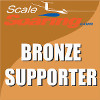I will be assembling a 5 meter scale sailplane that will have dual airborne batteries, each about 5000Mah. I've noticed that some vendors sell's large capacity Li-po's and some sell large capacity Li-ion's.
Are there any reasons to pick one over the other ?
Are there any reasons to pick one over the other ?



 I use LiFe batts for radios and LiPo's for high current applications like motor batteries. The main advantage to LiFe is their ability to hold a peak charge or to remain at a low charge state without damaging the cells so there is less maintenance/charging/discharging. LiPo's have to be stored at a certain voltage or you are risking a shorter lifespan for the battery, but they can handle higher discharge rates. LiFe's are also lower voltage so your regulators have to do less work if you are running your system at a lower voltage than the pack's nominal rating.
I use LiFe batts for radios and LiPo's for high current applications like motor batteries. The main advantage to LiFe is their ability to hold a peak charge or to remain at a low charge state without damaging the cells so there is less maintenance/charging/discharging. LiPo's have to be stored at a certain voltage or you are risking a shorter lifespan for the battery, but they can handle higher discharge rates. LiFe's are also lower voltage so your regulators have to do less work if you are running your system at a lower voltage than the pack's nominal rating.


Comment